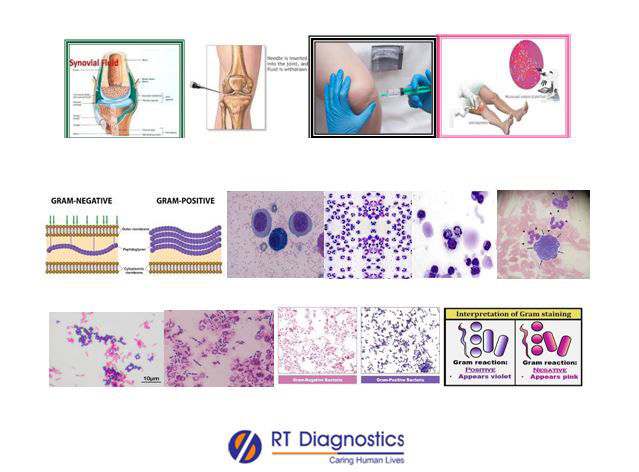Gram Stain- Synovial Fluid:
Why Gram Stain (Synovial Fluid) Test?
CLINICAL INFORMATION
The synovial fluid analysis is also known as joint fluid analysis may be ordered to help diagnose the cause of joint inflammation, pain, swelling and fluid accumulation. The function of the synovial fluid is to supply nutrition and disposal of metabolic end products, lubricate the joints and absorbs shock. Diseases associated with synovial fluid are of two types - Inflammatory type and Non-Inflammatory type. Some of the diseases are an auto-immune disease that leads to chronic synovitis (inflammation of synovial membrane), degenerative osteoarthritis (synovial fluid becomes less viscous and inflammatory substances come into direct contact with sensory nerve cells in the joints producing pain), rheumatoid arthritis, gout, tubercular arthritis (mycobacterium tuberculi – acid-fast bacilli), pyogenic arthritis or septic arthritis (increased amount of lactate accumulation), systemic lupus erythematosus, psoriatic arthritis, ankylosing spondylitis etc. The test analysis checks for changes in the physical properties like colour, viscosity and screens for changes in the fluid’s biochemical composition. Determination of inflammatory infiltrate is detected by adding acetic acid to the synovial fluid specimen. If a mucin clot is formed it shows the presence of inflammatory cells. Estimation of lactate levels in septic arthritis. Symptoms include pain, stiffness, swelling, cracking sound (since synovial fluid level reduces to fill the expanding volume of the joints negative pressure is formed and carbon-di-oxide gets filled up in the space and this bubble formation is called as cavitation leading to crackling sound) etc. Gram Stain Test: This test checks for the presence of harmful pathogenic microbes in suspected infection, for example in the throat, lungs, skin wounds, genitals etc and moreover in body fluids such as blood, urine etc. The two main categories of bacterial infections are gram-positive and gram-negative. This screening for diagnosis is done by the differentiation made, based on how the bacteria react to the gram stain. A gram stain is coloured purple and if the bacteria remain in purple colour it is gram-positive bacteria and incases the bacteria turns red or pink they are gram-negative bacteria. Examples of gram-positive bacteria include nosocomial infection caused by methicillin resistant Streptococcus aureus (MRSA), Strep infections, toxic shock etc. Examples of gram-negative infections include Salmonella, pneumonia, gonorrhea, UTI etc. The significance of differentiating the nature of bacteria as gram-positive or gram-negative helps the physician to begin the most effective antibiotic therapy for treating it. If the test result shows the presence of more than (≥15) colonies along with the same organism isolated from peripheral blood along with clinical signs and symptoms, then the case is said to be an infected positive case. Other gram stain tests include the Acid Fast Test (eg. For mycobacterium causing TB etc). Clinical manifestations include chills, fever, fatigue, nausea, confusion, increased heart rate, nasal flare due to increased breathing -which may or may not be associated with shortness of breath on physical exertion, inflammation (presenting with cardinal signs of inflammation like – rubor, tumor, calor, dolor and loss of function), blood clots, drop in blood pressure, organ failure, elevated WBCs etc. Once tested positive, then the additional supportive tests are ordered for - Evidence-Based Therapy (EBT) such as CBC, test for the presence of bacterial toxins (release of toxic by-products) eg staphylococcal infection, in case of foodborne-illness/food poison (or their toxins), different sample specimen collected for tests eg. blood, stool, urine culture, sputum test, CSF sampling, ascetic fluid, pleural fluid, pericardial fluid, synovial fluid, complement test (to check for increased levels of C3) etc. Moreover, sensitivity tests (also known as susceptibility testing) are also performed for appropriate antibiotic treatment & for better prognosis eg. MRSA – Methicillin-Resistant Staphylococcus aureus, VMSA Vancomycin-Resistant Staphylococcus aureus etc. Other tests other than culture and sensitivity of semen for the source of infection includes microscopic examination and evaluation of semen analysis, blood tests like CBC, differential WBC count (in case of infection), Prostate-Specific Antigen test, testosterone, FSH, ELISA test for Mumps antibodies etc, other hormonal assays eg. pituitary hormones (in case of tumours etc), urinalysis to check for UTI, digital rectal examination to confirm pain and swelling of the prostate, CT Scan, ultrasound (vericocele), genetic tests like DNA etc.

General Instructions:
Sample Requirement: Specimen – synovial fluid. Test Preparation: None.
NOTE - Sample for specimen collections may vary based on the patient’s condition/cases according to the patient’s presenting complaints/signs or symptoms:
SPECIMEN REQUIREMENT (Special or Rare Cases) - As instructed and guided by Physician / Clinician / Pathologist / as per Laboratory’s requirements, according to procedures and protocols.
This Multi-Specialty Clinical Referral Laboratory RT DIAGNOSTICS provides precise and accurate tests with an extensive range of testing services to the medical centres to help in the diagnosis and identification of pathology in the test specimens for infectious diseases and also to evaluate the function of organ systems of the patient. It prevents further complications and helps to stabilize and restore health to near normalcy at the earliest without delay.



